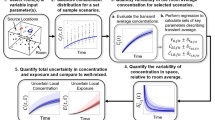Abstract
In order to provide realistic ventilation flow rates, it is of great importance to know indoor pollutant concentration field quickly and efficiently resulting from any type of indoor-pollutant-source distribution, further facilitating the design and control of indoor ventilation systems for practical application. This work introduces the development of reduced-order ventilation models for transient pollutant dispersion. In particular, we focus on transients resulting from a step change in pollutant source distributions. We further focus on the decay problem. A reduced-order ventilation model is the solution for this decay problem, which is derived from a large coupled system of Ordinary Differential Equations (ODEs) for concentration that can be cast in terms of a matrix exponential, that is accurately represented with only a few dominant eigenmodes. Using a 2D ventilation case, dominant eigenmodes with their physical relevance and pollutant concentration results are presented. We find that the first 4 eigenmodes are sufficient to predict the pollutant concentration decay for the current test case. We also find that the complex eigenmodes play an important role in the indoor recirculation processes.
Similar content being viewed by others
References
Boyce WE, DiPrima RC (1992). Elementary Differential Equations, 5th edn. New York: John Wiley & Sons.
Cao S-J, Meyers J (2012). On the construction and use of linear lowdimensional ventilation models. Indoor Air, 22: 427–441.
Cao S-J, Meyers J (2013). Influence of turbulent boundary conditions on RANS simulations of pollutant dispersion in mechanically ventilated enclosures with transitional slot Reynolds number. Building and Environment, 59: 397–407.
Cao S-J, Meyers J (2014). Asymptotic conditions for the use of linear ventilation models in the presence of buoyancy forces. Building Simulation, 7: 131–136
Campos C, Roman JE, Romero E, Tomas A (2012). SLEPc Users Manual. Technical Report, DSIC-II/24/02 - Revision 3.3, Universitat Politècnica de València.
Chang KC, Hsieh WD, Chen CS (1995). A modified low-Reynoldsnumber turbulence model applicable to recirculating flow in pipe expansion. ASME: Journal of Fluids Engineering, 117: 417–423.
Emmerich SJ, Persily AK (2001). State-of-the-art review of CO2-based demand controlled ventilation technology and application. NISTIR 6729.
Ferziger JH, Peric M (2002). Computational Methods for Fluid Dynamics. London: Springer.
Gockenbach MS (2010). Partial Differential Equations: Analytical and Numerical Methods, 2nd edn. Philadelphia, USA: Society for Industrial and Applied Mathematics.
Hernandez V, Roman JE, Vidal V (2005). SLEPc: A scalable and flexible toolkit for the solution of eigenvalue problems. ACM Transactions on Mathematical Software, 31: 351–362.
van Hooff T, Blocken B, van Heijst GJF (2013). On the suitability of steady RANS CFD for forced mixing ventilation at transitional slot Reynolds numbers. Indoor Air, 23: 236–249.
Ockendon J, Howison S, Lacey A, Movchan A (1999). Applied Partial Differential Equations. Oxford, UK: Oxford University Press.
Author information
Authors and Affiliations
Corresponding author
Rights and permissions
About this article
Cite this article
Cao, SJ., Meyers, J. Fast prediction of indoor pollutant dispersion based on reduced-order ventilation models. Build. Simul. 8, 415–420 (2015). https://doi.org/10.1007/s12273-015-0240-9
Received:
Revised:
Accepted:
Published:
Issue Date:
DOI: https://doi.org/10.1007/s12273-015-0240-9




